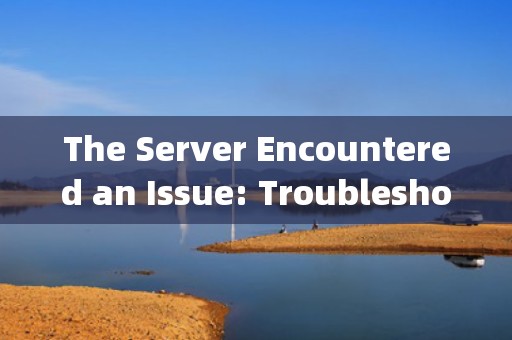In today's digital age, servers are the backbone of our interconnected world. They store, process, and manage data for websites, applications, and services that we rely on daily. However, even the most robust servers can encounter problems from time to time. When a server goes down or starts malfunctioning, it can cause significant disruptions, leading to frustration for both administrators and end-users. This article delves into the common issues that servers face, their potential causes, and effective troubleshooting methods to get things back up and running smoothly.

Understanding Server Problems
A "server problem" is a broad term that encompasses a range of issues, from hardware failures and software bugs to network connectivity problems and security breaches. Identifying the root cause of a server issue is crucial for implementing the right solution. Let's explore some of the most frequent server problems and their indicators.
Hardware Failures
Hardware issues can stem from various components within the server, including the motherboard, CPU, RAM, hard drives, or power supply. Signs of hardware failure may include:
- Unexpected shutdowns or reboots
- Error messages related to specific hardware components
- Slow performance or unresponsiveness
- Overheating or unusual noises (e.g., beeping, clicking)
Regular maintenance, such as cleaning dust from fans and ensuring proper ventilation, can prevent many hardware-related problems. Additionally, using redundant hardware (like RAID configurations for storage) can help mitigate the impact of component failures.
Software and Configuration Issues
Software glitches and misconfigurations are among the most common reasons for server problems. These can manifest as:
- Application crashes or errors
- Inability to connect to databases or other services
- Performance degradation under load
- Security vulnerabilities due to outdated software
Regularly updating software, applying security patches, and conducting routine backups are essential practices to maintain server health. It's also wise to have a disaster recovery plan in place, should a critical failure occur.
Network Connectivity Problems
Network issues can disrupt server accessibility, causing slow response times or complete outages. Common symptoms include:
- Intermittent loss of connectivity
- High latency or packet loss
- Inability to ping or access the server remotely
Troubleshooting network problems often involves checking physical connections, router configurations, and firewall settings. Using network monitoring tools can help identify bottlenecks or abnormal traffic patterns.
Security Breaches
Cyberattacks, such as DDoS attacks, malware infections, or unauthorized access, pose severe threats to server security. Indicators of security breaches might include:
- Sudden spikes in resource usage (CPU, memory)
- Unusual network activity or port scans
- Alerts from security software or monitoring systems
Implementing strong passwords, two-factor authentication, and regular security audits can bolster server defenses against potential threats.
Troubleshooting Steps
When faced with a server problem, a systematic approach to troubleshooting is key. Here's a step-by-step guide:
1、Identify the Symptoms: Gather information about the issue, noting any error messages, unusual behavior, or recent changes made to the system.
2、Check Logs: Server logs can provide valuable insights into what went wrong. Look for patterns, errors, or warnings that coincide with the problem's onset.
3、Isolate the Problem: Determine if the issue affects all users or just a subset. This can help narrow down whether it's a network, application, or hardware problem.
4、Restart Services: Sometimes, simply restarting affected services or the entire server can resolve temporary glitches.
5、Run Diagnostic Tools: Use built-in or third-party diagnostic utilities to check the health of hardware components and system resources.
6、Review Recent Changes: If the problem started after recent updates or configuration changes, consider rolling back those modifications to see if they were the cause.
7、Consult Documentation and Support: Refer to official documentation, forums, or reach out to technical support for guidance on complex issues.
8、Implement a Fix: Once the root cause is identified, apply the necessary fix, whether it's replacing faulty hardware, adjusting configurations, or applying software patches.
9、Monitor and Prevent Future Issues: After resolving the issue, closely monitor the server for any recurrence of and take preventive measures to avoid similar problems in the future.
Conclusion
Server problems are an inevitable part of managing IT infrastructure, but with proactive monitoring, regular maintenance, and effective troubleshooting strategies, their impact can be minimized. By understanding the common types of server issues and how to address them, administrators can ensure their systems remain reliable, secure, and efficient. Remember, preparation and quick response are vital in maintaining uptime and user satisfaction in today's technology-dependent world.
随着互联网的普及和信息技术的飞速发展台湾vps云服务器邮件,电子邮件已经成为企业和个人日常沟通的重要工具。然而,传统的邮件服务在安全性、稳定性和可扩展性方面存在一定的局限性。为台湾vps云服务器邮件了满足用户对高效、安全、稳定的邮件服务的需求,台湾VPS云服务器邮件服务应运而生。本文将对台湾VPS云服务器邮件服务进行详细介绍,分析其优势和应用案例,并为用户提供如何选择合适的台湾VPS云服务器邮件服务的参考建议。

工作时间:8:00-18:00
电子邮件
1968656499@qq.com
扫码二维码
获取最新动态
